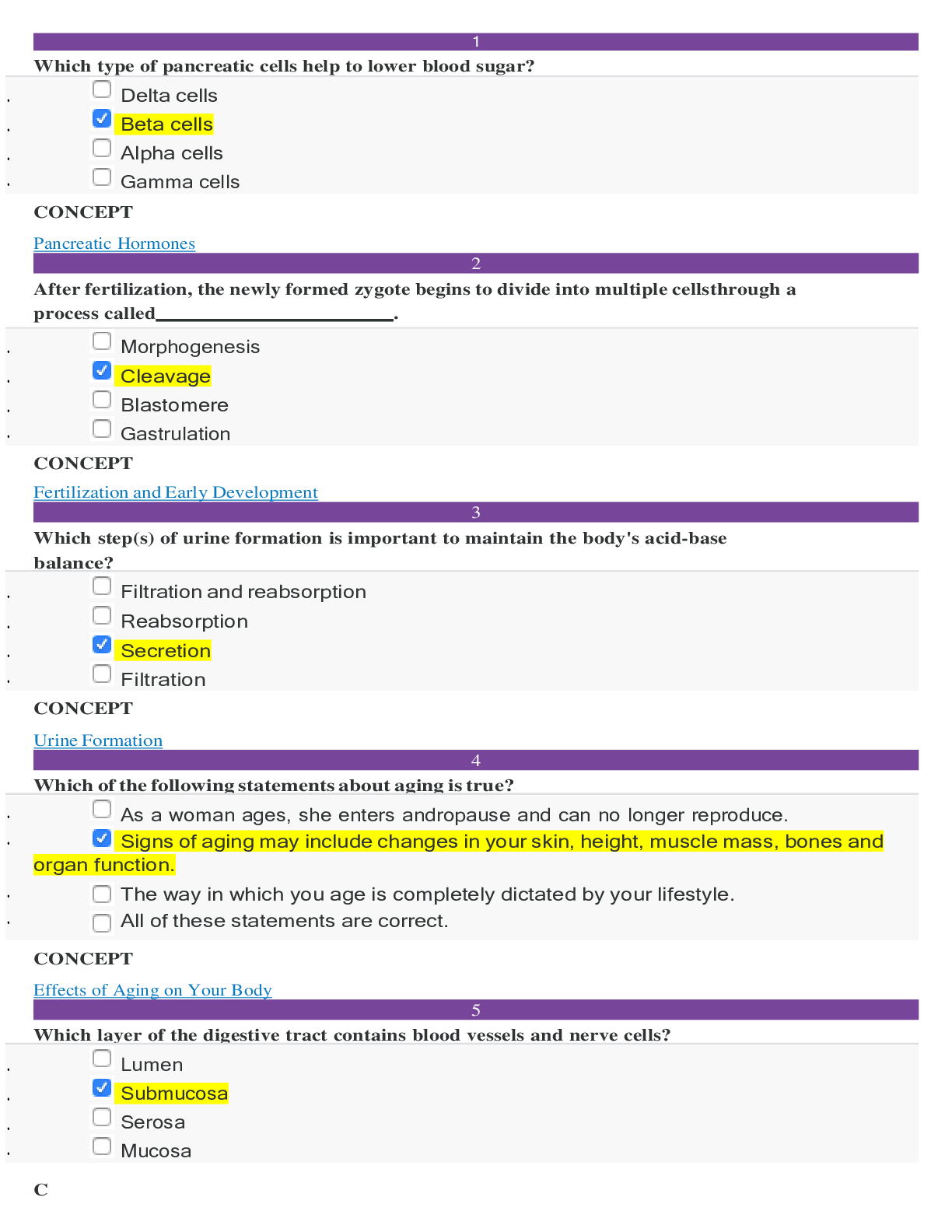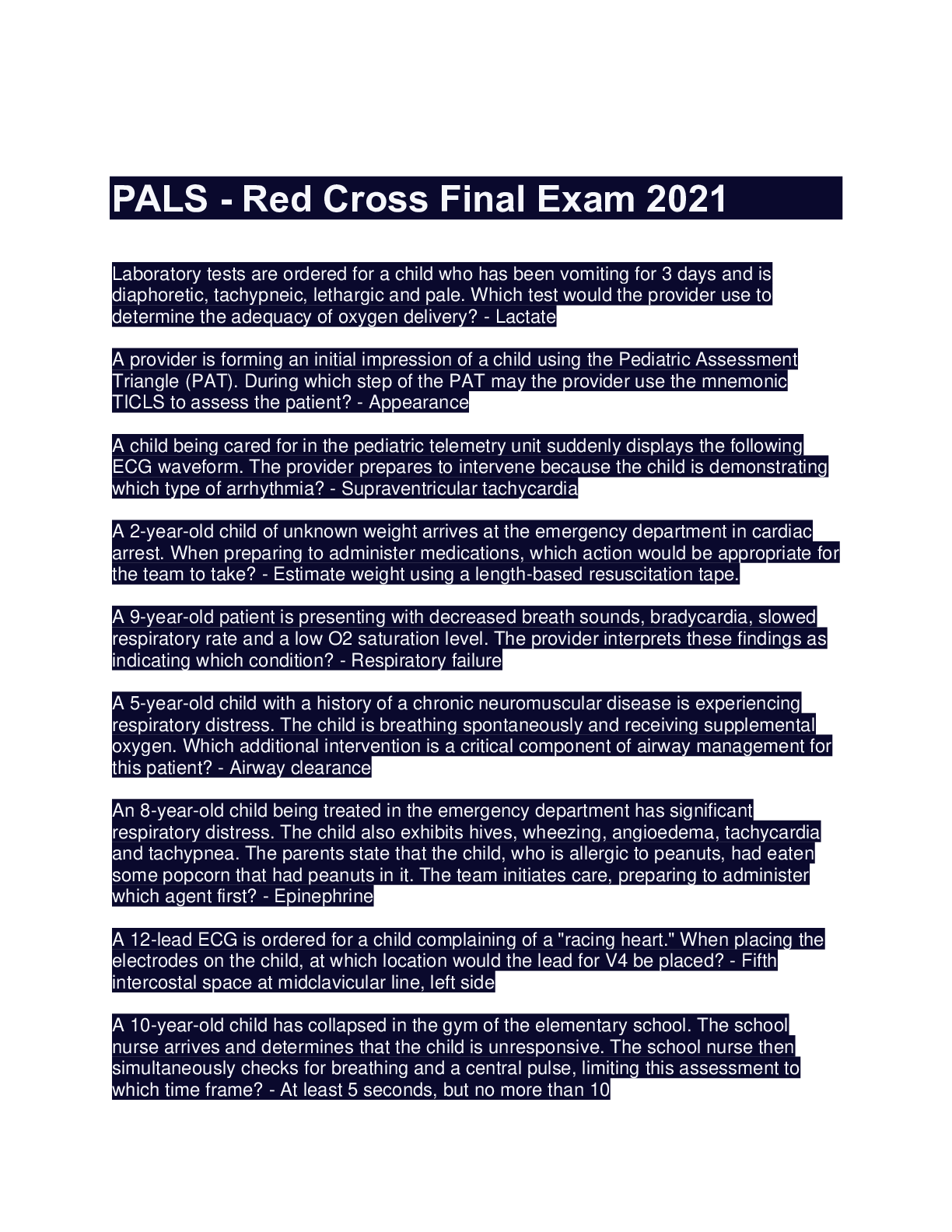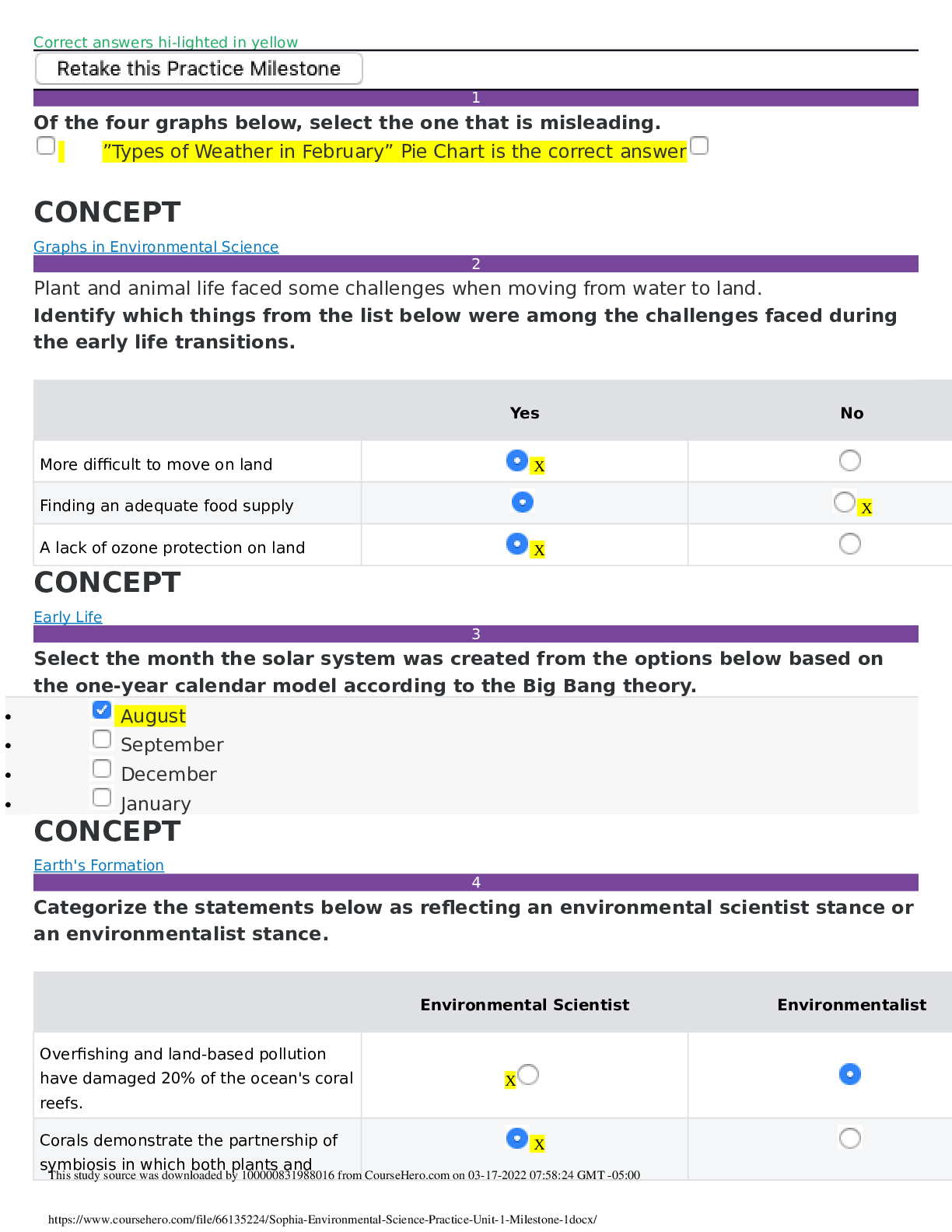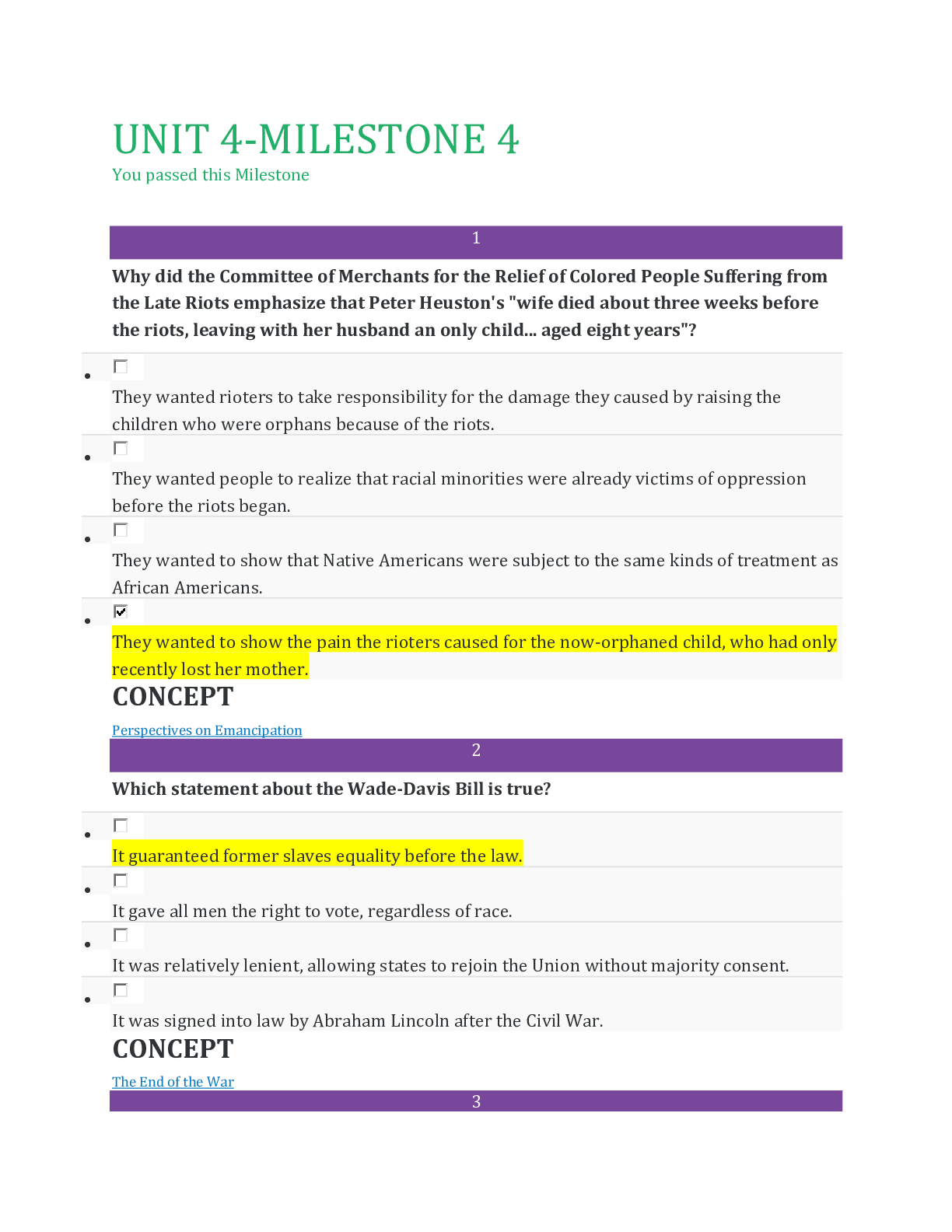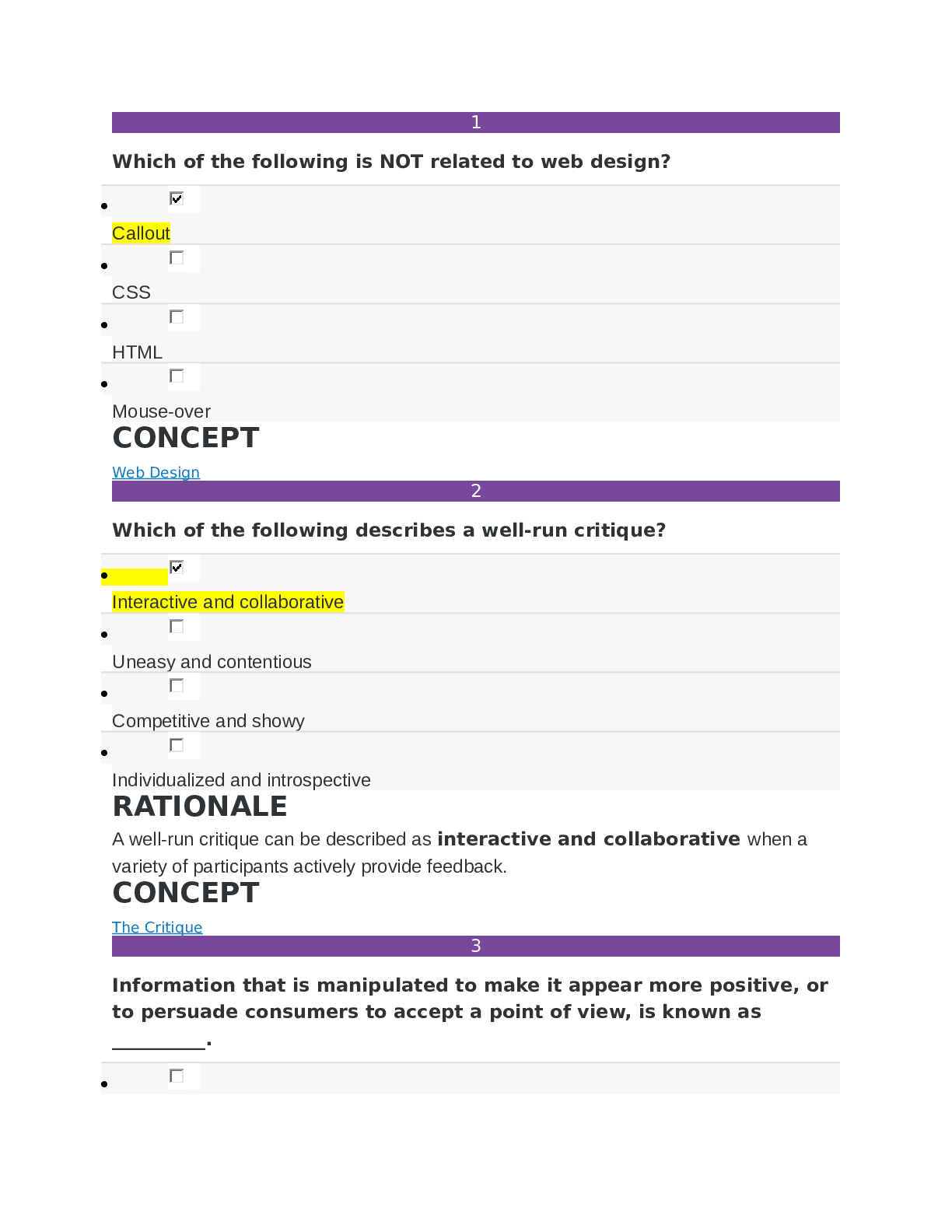Statistics > SOPHIA PATHWAY > MAT 300 Unit_3_Milestone_3_Statisitic_Exam_(2020) - Sophia University | MAT300 Unit_3_Milestone_3_St (All)
MAT 300 Unit_3_Milestone_3_Statisitic_Exam_(2020) - Sophia University | MAT300 Unit_3_Milestone_3_Statisitic_Exam_(2020)
Document Content and Description Below
MAT 300 Unit_3_Milestone_3_Statisitic_Exam_(2020) - Sophia University | MAT300 Unit_3_Milestone_3_Statisitic_Exam_(2020) 1 CONCEPT Theoretical Probability/A Priori Method 2 CONCEPT "Either/Or" P... robability for Overlapping Events 3 CONCEPT Odds 4 CONCEPT Geometric Distribution 5 CONCEPT "Either/Or" Probability for Non-Overlapping Events 6 CONCEPT Expected Value 7 CONCEPT Binomial Distribution 8 CONCEPT Complement of an Event 9 CONCEPT Outcomes and Events 10 CONCEPT "And" Probability for Dependent Events 11 CONCEPT Fundamental Counting Principle 12 CONCEPT Venn Diagrams 13 CONCEPT "Either/Or" Probability for Overlapping Events 14 CONCEPT "And" Probability for Independent Events 15 CONCEPT Normal Distribution Approximation of the Binomial Distribution 16 CONCEPT Law of Large Numbers/Law of Averages 17 CONCEPT False Positives/False Negatives 18 CONCEPT Conditional Probability and Contingency Tables 19 CONCEPT Overlapping Events 20 You passed this Milestone 19 questions were answered correctly. 7 questions were answered incorrectly. 1 question was skipped. These were marked incorrect. A bag contains 8 red marbles, 7 blue marbles, and 6 green marbles. Adam randomly picks out a marble from the bag. What is the theoretical probability that Adam will pick a blue marble from the bag? RATIONALE Recall that there are 7 blue marbles and a total of 8+7+6 = 21 marbles overall. The probability of a blue is: The gender and age of Acme Painting Company's employees are shown below. Age Gender 23 Female 23 Male 24 Female 26 Female 27 Male 28 Male 30 Male 31 Female 33 Male 33 Female 33 Female 34 Male 36 Male 37 Male 38 Female 40 Female 42 Male 44 Female If the CEO is selecting one employee at random, what is the chance he will select a male OR someone in their 40s? RATIONALE Since it is possible for an employee to be a male and a person in their 40s, these two events are overlapping. We can use the following formula: Of the 18 employees, there are 9 females and 9 males, so . There are a total of 3 people in their 40s, so . Of the people in their 40s, only one is male so . There is a 30% chance of rain tomorrow. What are the odds in favor of it raining? RATIONALE Recall that we if we have a probability " ", we can formally express odds as " ". So if the probability is 30%, or 30/100 in fraction form, then we can express odds as: John makes random guesses on his multiple-choice test, which has five options for each question. Let the random variable X be the number of guesses taken before guessing correctly. Assuming the guesses are independent, find the probability that he doesn't guess correctly until his 6th guess. RATIONALE Since we are looking for the probability until the first success, we will use the following Geometric distribution formula: The variable k is the number of trials until the first success, which in this case, is 6 guesses. The variable p is the probability of success, which in this case, a success is considered getting a question right on a multiple-choice test with five options, which would be 1/5 or 0.2. Zhi and her friends moved on to the card tables at the casino. Zhi wanted to figure out the probability of drawing a King of clubs or an Ace of clubs. Choose the correct probability of drawing a King of clubs or an Ace of clubs. Answer choices are in the form of a percentage, rounded to the nearest whole number. RATIONALE Since the two events, drawing a King of Clubs and drawing an Ace of Clubs, are non-overlapping, we can use the following formula: Dida bought a scratch ticket for $2.00. The potential payoffs and probability of those payoffs are shown below. Value (in $) Probability 0.00 0.15 0.50 0.50 1.00 0.20 2.00 0.10 10.00 0.05 What is the expected value for the scratch ticket that Dida bought? RATIONALE The expected value, also called the mean of a probability distribution, is found by adding the products of each individual outcome and its probability. We can use the following formula to calculate the expected value, E(X): Which of the following is a property of binomial distributions? RATIONALE Recall that for any probability distribution, the sum of all the probabilities must sum to 1. What is the probability of NOT drawing a Queen from a standard deck of 52 cards? RATIONALE Recall that the probability of a complement, or the probability of something NOT happening, can be calculated by finding the probability of that event happening, and then subtracting from 1. Note that there are a total of 4 Queen cards in a standard deck of 52 cards. So the probability of NOT getting a Queen is equivalent to: Jake tosses a coin and rolls a six-sided die. All of the following are possible outcomes EXCEPT: RATIONALE Recall a coin has heads and tails and a standard die has six values, {1, 2, 3, 4, 5, or 6}. So, obtaining a value of 7 is not possible. Patricia was having fun playing poker. She needed the next two cards dealt to be spades so she could make a flush (five cards of the same suit). There are 12 cards left in the deck, and three are spades. What is the probability that the two cards dealt to Patricia (without replacement) will both be spades? Answer choices are in percentage format, rounded to the nearest whole number. RATIONALE If there are 12 cards left in the deck with 3 spades, the probability of being dealt 2 spades if they are dealt without replacement means that we have dependent events because the outcome of the first card will affect the probability of the second card. We can use the following formula: The probability that the first card is a spade would be 3 out of 12, or . The probability that the second card is a spade, given that the first card was also a spade, would be because we now have only 11 cards remaining and only two of those cards are spades (since the first card was a spade). So we can use these probabilities to find the probability that the two cards will both be spades: For a math assignment, Jane has to roll a set of six standard dice and record the results of each trial. She wonders how many different outcomes are possible after rolling all six dice. What is the total number of possible outcomes for each trial? RATIONALE We can use the general counting principle and note that for each step, we simply multiply all the possibilities at each step to get the total number of outcomes. Each die has 6 possible outcomes, so the overall number of outcomes for rolling 6 die with 6 possible outcomes each is: Two sets A and B are shown in the Venn diagram below. Which statement is TRUE? RATIONALE The intersection, or middle section, would show the common elements, which is 3. The number of elements of Set A is everything in Circle A, or 8+3 = 11 elements, not 8 elements. The number of elements of Set B is everything in Circle B, or 7+3 = 10 elements, not 7 elements. To get the total number of items in the Venn diagram, we add up what is in A and B and outside, which is 8+3+7+2=20 elements, not 2 elements. Using this Venn diagram, what is the probability that event A or event B occurs? RATIONALE To find the probability that event A or event B occurs, we can use the following formula for overlapping events: The probability of event A is ALL of circle A, or 0.24 + 0.41 = 0.65. The probability of event B is ALL of circle B, or 0.12 + 0.41 = 0.53. The probability of event A and B is the intersection of the Venn diagram, or 0.41. We can also simply add up all the parts = 0.24 + 0.41 + 0.12 = 0.77. Carl throws a single die twice in a row. For the first throw, Carl rolled a 2; for the second throw he rolled a 4. What is the probability of rolling a 2 and then a 4? Answer choices are in the form of a percentage, rounded to the nearest whole number. RATIONALE The two events (first roll and second roll) are independent of each other. To find the probability of getting a 2 on the first roll and getting a 4 on the second roll, we can use the following formula: Note that the probability of rolling a two is , and rolling a four is the same probability, . Mark looked at the statistics for his favorite baseball player, Jose Bautista. Mark looked at seasons when Bautista played 100 or more games and found that Bautista's probability of hitting a home run in a game is 0.173. If Mark uses the normal approximation of the binomial distribution, what will be the variance of the number of home runs Bautista is projected to hit in 100 games? Answer choices are rounded to the tenths place. RATIONALE In this situation, we know: n = sample size = 100 p = success probability = 0.173 We can also say that q, or the complement of p, equals: q = 1 - p = 1 - 0.173 = 0.827 The variance is equivalent to n*p*q: Sarah throws a fair die multiple times, recording the total number of "2"s she throws and then calculating the proportion of "2"s she has thrown so far after each throw. She then constructs a graph to visualize her results. Which of the following statements is FALSE? RATIONALE The probability distribution for the outcomes doesn't change; however, the sampling distribution for the outcomes does. Which of the following is an example of a false positive? RATIONALE Sending a man to jail, when in fact he is innocent, is a false positive. A credit card company surveys 125 of its customers to ask about satisfaction with customer service. The results of the survey, divided by gender, are shown below. Males Females Extremely Satisfied 25 7 Satisfied 21 13 Neutral 13 16 Dissatisfied 9 14 Extremely Dissatisfied 2 5 If you were to choose a female from the group, what is the probability that she is satisfied with the company's customer service? Answer choices are rounded to the hundredths place. RATIONALE The probability of a person being "satisfied" given she is a female is a conditional probability. We can use the following formula: Remember, to find the total number of females, we need to add all values in this column: 7 + 13 + 16 + 14 + 5 = 55. Select the following statement that describes non-overlapping events. RATIONALE Events are non-overlapping if the two events cannot both occur in a single trial of a chance experiment. Since he wants a red card {Ace, 2, 3, 4, 5, 6, 7, 8, 9, 10, Jack, Queen, or King: In either Diamond or Hearts} and he got the Five of Clubs, there is no overlap. ! 1/18 " 1/3 ! 11/18 1/2 3:10 10:3 7:3 ! 3:7 0.3277 ! 0.0655 0.0789 0.3521 6% ! 4% 8% 2% $2.00 ! $1.15 $1.50 $0.50 There are exactly three possible outcomes for each trial. The expected value is equal to the number of successes in the experiment. ! The sum of the probabilities of successes and failures is always 1. All trials are dependent. " ! Tails, One Tails, Three Heads, Five ! Heads, Seven 25% 17% ! 5% " 18% 216 36 ! 46,656 7,776 Set B has 7 elements. Set A has 8 elements. There are a total of 2 elements shown in the Venn diagram. ! Sets A and B have 3 common elements. ! 0.77 0.41 " 0.36 0.68 36% ! 3% " 33% 22% 3.8 17.3 ! 14.3 0.8 The relative frequency of "2"s thrown changes as Sarah throws the die more. The theoretical probability of getting a 2 is 0.167 for each throw. This is an example of the law of large numbers. The probability distribution for the possible number of outcomes ! changes as the total number of throws increases. Sending a guilty man to jail. ! Sending an innocent man to jail. A medical test coming back negative for a disease you don't have. A medical test coming back positive for a disease you do have. 0.62 " 0.13 ! 0.24 0.38 Luke wants a red card so he can have a winning hand, and he receives ! the five of clubs. Luke needs to roll an odd number to win. When it’s his turn, he rolls a five. To win, Luke needs a black card. He receives an eight of spades. Receiving the Queen of Diamonds fulfills Luke's need of getting both a face card and a diamond. UNIT 3 — MILESTONE 3 19/27 SCORE https://www.coursehero.com/file/62819840/Unit-3-Milestone-3-Statisitic-Exam-pdf/CONCEPT Independent vs. Dependent Events 21 CONCEPT Poisson Distribution 22 CONCEPT Conditional Probability 23 CONCEPT Paradoxes 24 CONCEPT Conditional Probability 25 CONCEPT Probability Distribution 26 CONCEPT Relative Frequency Probability/Empirical Method 27 CONCEPT Two-Way Tables/Contingency Tables John is playing a game with a standard deck of playing cards. He wants to draw a jack on the first try. Which of the following statements is true? RATIONALE Events are said to be independent if one event does not influence the likelihood of the other. Since John re-shuffles the deck and puts the card back in the deck, the probability should be the same and the first draw will not influence the second. The average number of babies born at a private hospital's maternity wing is 6 per hour. What is the probability that three babies are born during a particular 1-hour period in this maternity wing? RATIONALE Since we are finding the probability of a given number of events happening in a fixed interval when the events occur independently and the average rate of occurrence is known, we can use the following Poisson distribution formula: The variable k is the given number of occurrences, which in this case, is 3 babies. The variable λ is the average rate of event occurrences, which in this case, is 6 babies. You skipped this question and it was marked incorrect. Using the Venn Diagram below, what is the conditional probability of event B occurring, assuming event A has happened [P(B|A)]? RATIONALE To get the probability of B given A has occurred, we can use the following conditional formula: The probability of A and B is the intersection, or overlap, of the Venn diagram, which is 0.41. The probability of A is all of Circle A, or 0.24 + 0.41 = 0.65. Kendra was trying to decide which type of frozen yogurt to restock based on popularity: flavors with chocolate or flavors without chocolate. After studying the data, she noticed that chocolate flavors sold best on the weekdays and on the weekends, but not best overall. Which paradox has Kendra encountered? RATIONALE This is an example of Simpson's paradox, which is when the trend overall is not the same that is examined in smaller groups. Since the sale of chocolate flavors is larger on the weekends, but this trend changes when looking at sales overall, this is a reversal of the trend. Paul went to a blackjack table at the casino. At the table, the dealer has just shuffled a standard deck of 52 cards. Paul has had good luck at blackjack in the past, and he actually got three blackjacks with Kings in a row the last time he played. Because of this lucky run, Paul thinks that Kings are the luckiest card. The dealer deals the first card to him. In a split second, he can see that it is a black card, but he is unsure if it is a King. What is the probability of the card being a King, given that it is a black card? Answer choices are in a percentage format, rounded to the nearest whole number. RATIONALE The probability of it being a King given it is a Black card uses the conditional formula: Note that in a standard deck of 52 cards, half of the cards are black, or 26 out of 52. Of those 26 black cards, only two are Kings. Which of the following situations describes a continuous distribution? RATIONALE Since the weight of newborns can be an infinite number of values, such as 8 pounds, 9 ounces, etc, this would be an example of a continuous distribution. Fifty people were asked whether they were left handed. Six people answered "yes." What is the relative frequency of left-handed people in this group? Answer choices are rounded to the hundredths place. RATIONALE The relative frequency of a left hand is: A credit card company surveys 125 of their customers to ask about satisfaction with customer service. The results of the survey, divided by gender, are shown below. Males Females Extremely Satisfied 25 7 Satisfied 21 13 Neutral 13 16 Dissatisfied 9 14 Extremely Dissatisfied 2 5 If a survey is selected at random, what is the probability that the person is a female with neutral feelings about customer service? Answer choices are rounded to the hundredths place. RATIONALE If we want the probability of selecting a survey that is from a female who marked "neutral feelings," we just need to look at the box that is associated with both categories, or 16. To calculate the probability, we can use the following formula: The probability that John draws a jack on the first try is 1/13. If John replaces the card, re-shuffles, and draws again, the probability that he will pull another jack decreases. The probability that John draws a jack on the first try is 1/13. If John replaces the card, re-shuffles, and draws again, the probability that he will pull another jack increases. The probability that John draws a jack on the first try is 1/13. If John replaces the card, re-shuffles, and draws again, the probability that he will pull another jack stays the same. ! The probability that John draws a jack on the first try is 3/13. If John replaces the card, re-shuffles, and draws again, the probability that he will pull another jack stays the same. 0.16 0.13 ! 0.09 0.20 0.77 0.41 0.24 0.63 False Negative False Positive ! Simpson's Paradox Benford's Law 67% 50% 23% ! 8% ! A probability distribution showing the weights of newborns A probability distribution showing the number of vaccines given to " babies during their first year of life A probability distribution showing the average number of days mothers spent in the hospital A probability distribution showing the amount of births in a hospital in a month 8.33 ! 0.12 0.88 1.14 ! 0.13 0.19 0.29 0.5 0.81 © 2020 SOPHIA Learning, LLC. SOPHIA is a registered trademark of SOPHIA Learning, LLC. About Contact Us Privacy Policy Terms of Use https://www.coursehero.com/file/62819840/Unit-3-Milestone-3-Statisitic-Exam-pdf/ ce was shared via CourseHero.com Powered by TCPDF (www.tcpdf.org) [Show More]
Last updated: 1 year ago
Preview 1 out of pages

Reviews( 0 )
Document information
Connected school, study & course
About the document
Uploaded On
Sep 14, 2020
Number of pages
Written in
Additional information
This document has been written for:
Uploaded
Sep 14, 2020
Downloads
0
Views
30


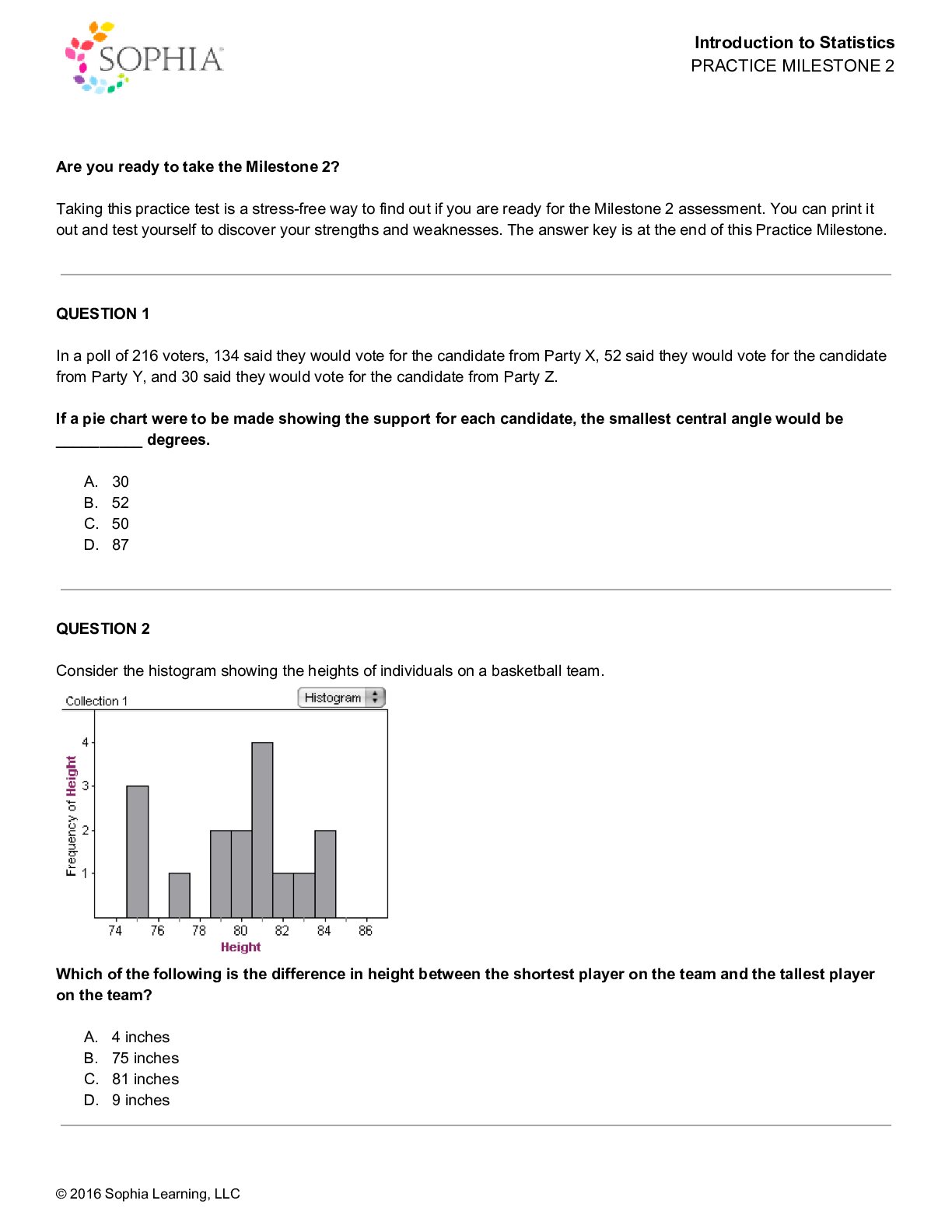
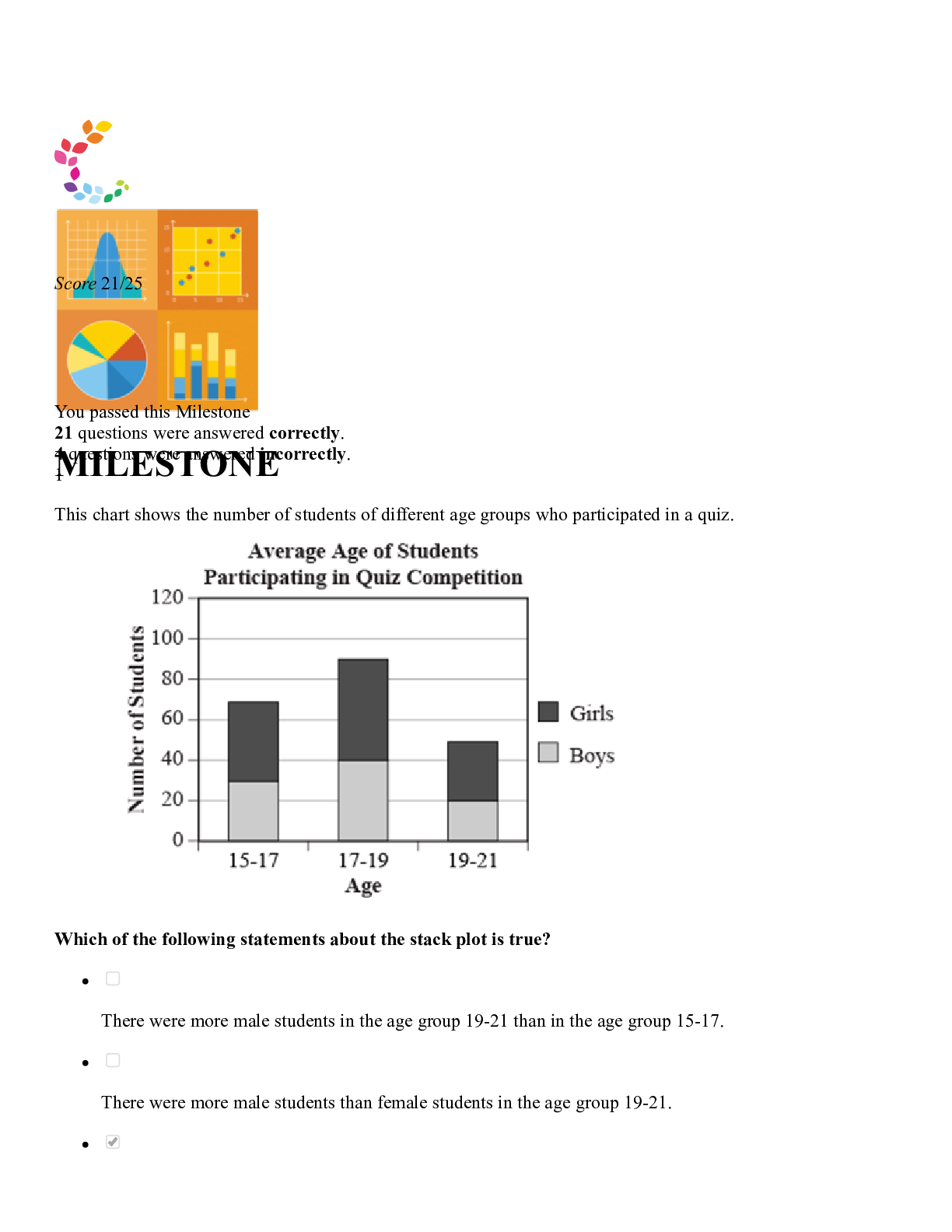


 – University of the People.png)
 – University of Maryland.png)
 – University of the People.png)
 – University of the People.png)
 – University of the People.png)



